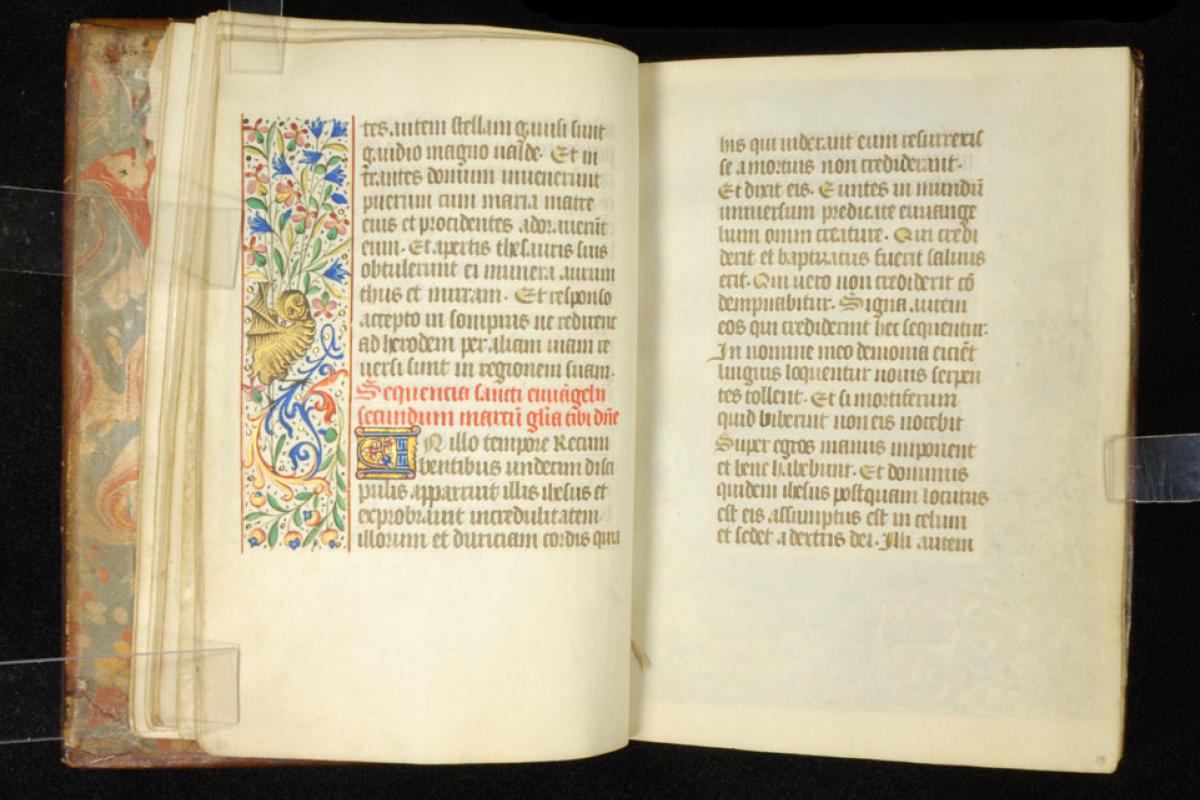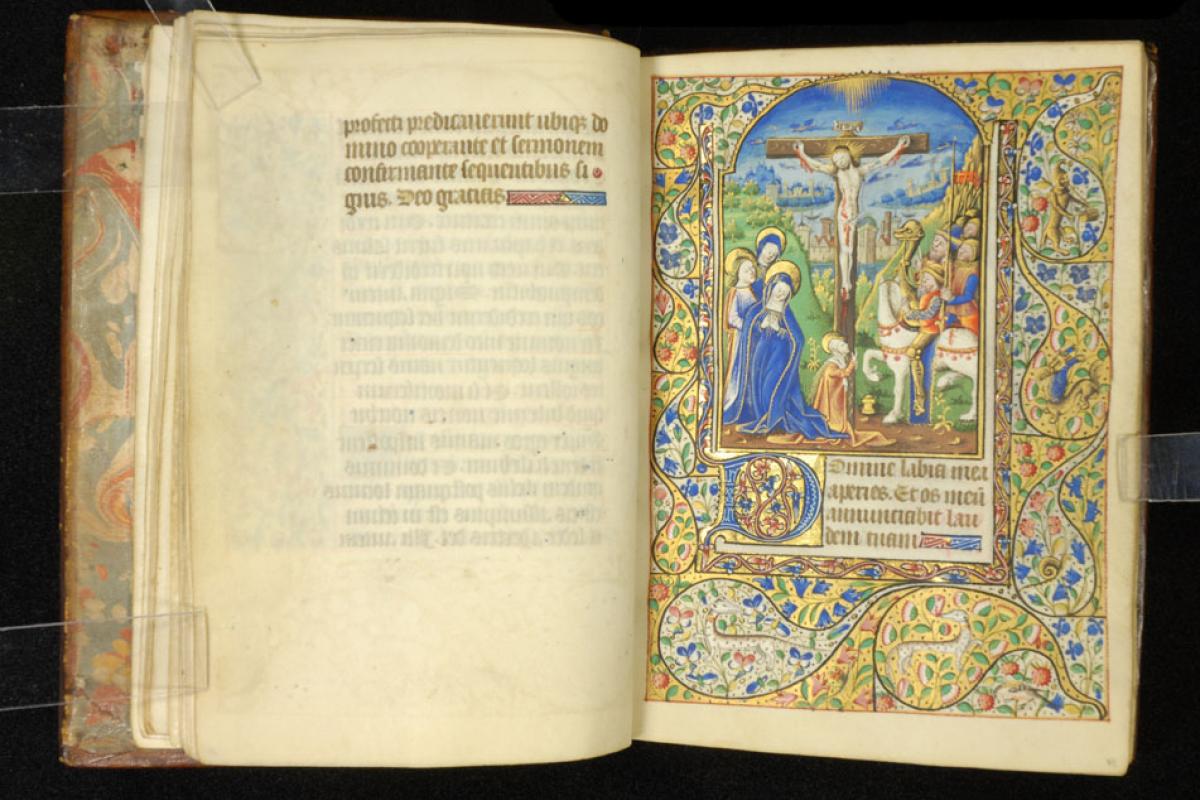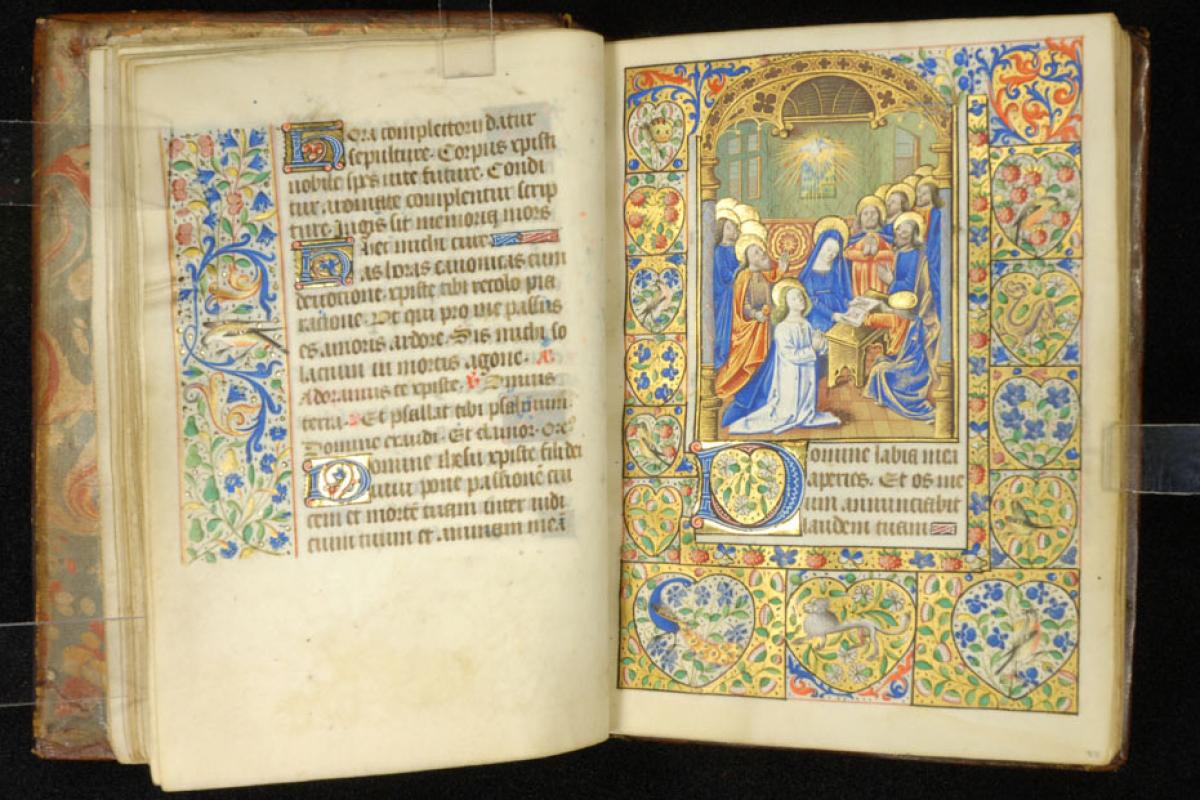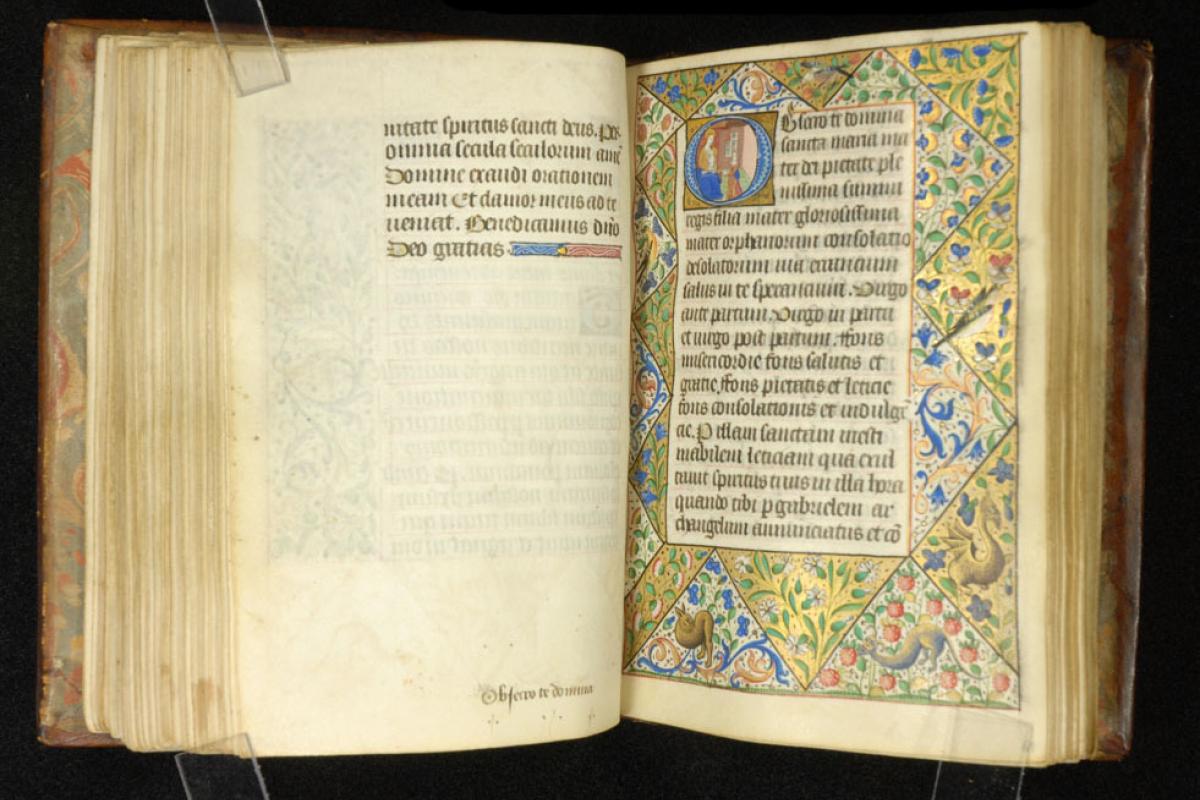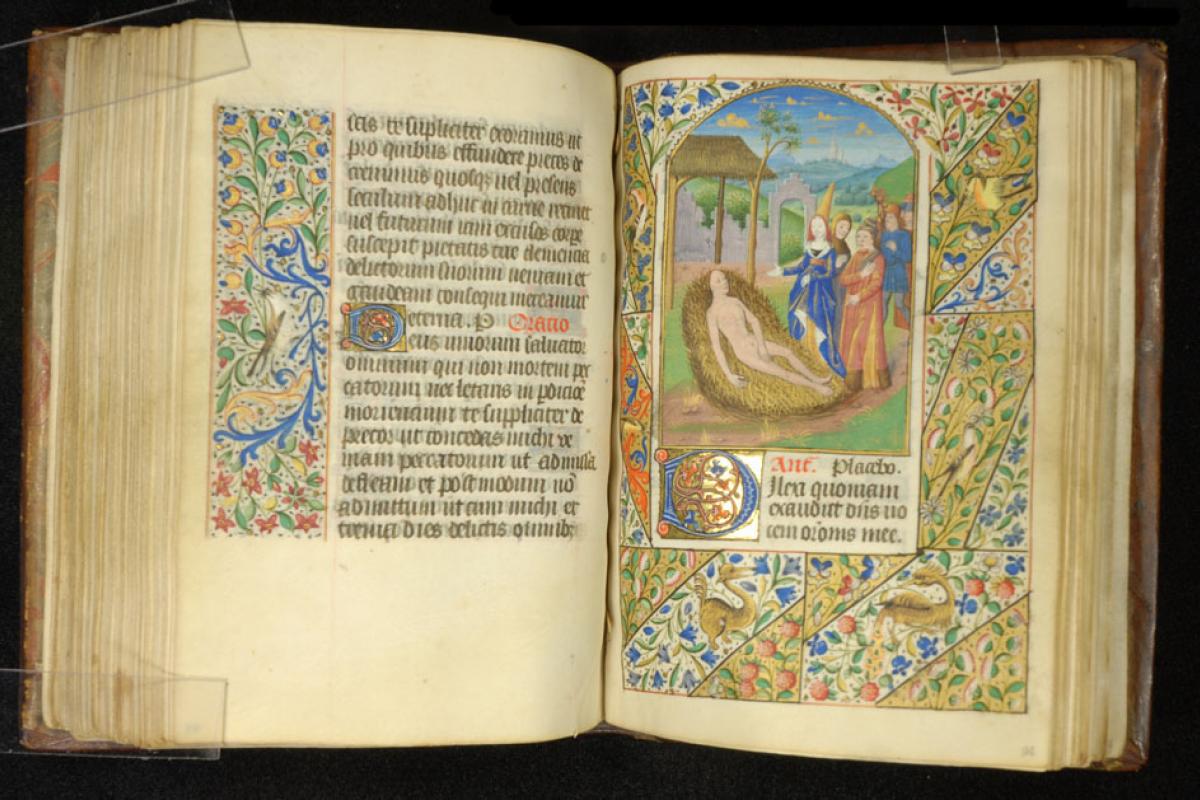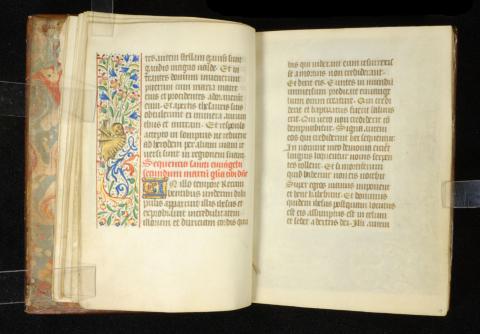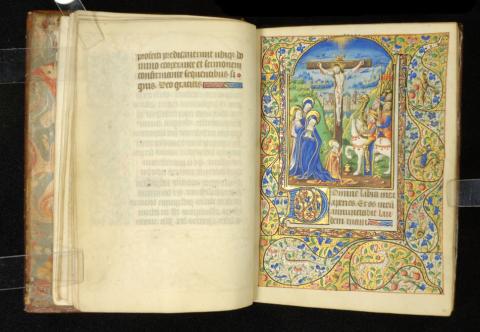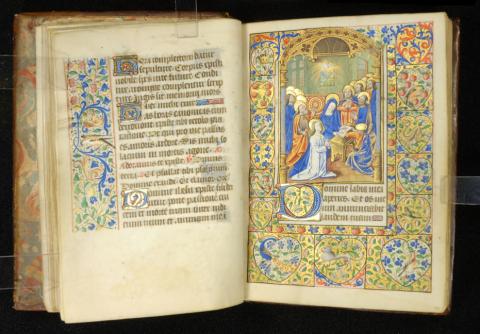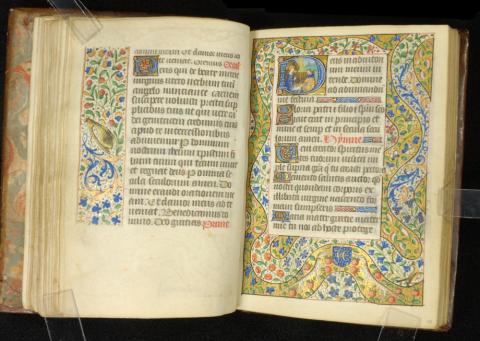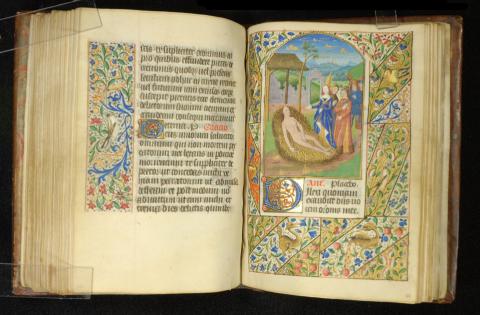Book of Hours, Use of Troyer | Bucherat-Peley Hours
Book of Hours, Use of Troyer (Bucherat-Peley Hours)
French, ca. 1475
Images:
fols. 12v-13r: Opening page of the Gospel extracts with Evangelist miniatures in each corner and coat of arms
folio with text and floral border
fols. 17v-18r: Crucifixion (Hours of the Cross)
fols. 23v-24r: Pentecost (Hours of the Holy Spirit)
fols. 45v-46r: Text pages, Initial "D" with Nativity
fols. 68v-69r: Text page, Initial "D" with Kneeling Female Patron before Virgin and Child (Prayer to the Virgin: Obsecro te Domina)
fols. 95v-96r: Job on the Dung Heap (Office of the Dead)
parchment
height 17.5 cm
width 12.7 cm
Mount Angel Abbey Library, Ms 65
Jeff Brown, Medieval Portland Research Assistant
The decorative quality of this otherwise standard manuscript, through the artists’ liberal use of gold and elaborate border décor, distinguishes it from other late fifteenth-century works from northern France.
The early owners of the book were the first mayor of Troyes, Edmond le Boucherat, and his wife Jeanne le Peley, of the late fifteenth century; the incorporation of a female donor portrait and decorative initials within loveknots suggest Jeanne gave the prayerbook to her husband as a wedding present. Saints appearing in the calendar, some fairly obscure, and the Hours of the Virgin further indicate connections to the diocese of Troyes.
Diebold, William. The Illustrated Book in the Age of Printing: Books and Manuscripts from Oregon Collections. Portland, OR: Douglas F. Cooley Memorial Art Gallery, 1993, p. 11 - Quoted with permission
6. Book of Hours, Use of Rome
Italy, second half of the 15th century
Mount Angel Abbey Library, MS 66
Fols. 193v-194f: Text pages and initial "P" with cross
9. Book of Hours, Use of Rome
Flanders, c. 1475
Mount Angel Abbey Library, MS 63
Fols. 32v-33r: Christ in the Garden of Gethsemane and Text page with border
10. Book of Hours, Use of Troyes (Boucherat-Peley Hours)
Troyes.c. 1475
Mount Angel Abbey Library, MS 65
Fols. 17v-18r: Text page and Crucifixion
These three manuscripts; made at approximately the same time in three different parts of Western Europe, indicate the universality of the Book of Hours in the late Middle Ages. Each manuscript is open to the same text, the Hours of the Cross, a series of prayers meant to remind the viewer of Christ's passion. In the Flemish Book, number 9, this text is illustrated with a miniature of Christ in the Garden of Gethsemane. In the Italian Book, number 6, the initial beginning the same text contains an image of Christ's cross on a hill. In the French Book of Hours, number 10, is a miniature of the familiar scene of Christ crucified.
That all three of these manuscripts contain the same texts is significant; the standardization and widespread distribution of identical texts is often considered a result of printing, impossible in a scribal culture. Books of Hours were so popular in the Middle Ages, however, that they were made by hand with a mechanization not unrelated to the mechanical production of early printed books. One sign of the assembly-line-like production of manuscript Books of Hours like these is their patronage. Of the three, only number 10 was made to order, the traditional reason medieval illuminated manuscripts were made. Its patrons were Edmond le Boucherat, the mayor of the city of Troyes, and his wife, Jeanne le Peley. Many pages of the book bear either their coats of arms or their interlocked initials. Numbers 6 and 9, however, were made not for a particular patron but for the market. (There is a blank space for a coat of arms in number 6 to allow its buyer to have it personalized.) These two books were made for sale over the counter and in that sense are like most early printed books.
Wilma Fitzgerald, PhD, SP - Quoted with permission from an unpublished study
Liber horarum (cum kalendario) (use of Troyes). Saec. XV ex. FF i (paper) + 134 + i (paper).172 x 128 (113 x 64) mm., 18 lines in Gothic script. Miniatures and historiated initials: Evangelist portraits in four corners, coat of arms bottom center, Crucifixion, Pentecost, Annunciation, in initials: D, Visitation, Nativity, Annunciation to the Shepherds, Adoration of the Magi, Presentation in the temple, Flight into Egypt, (Initial): C, Coronation of the Virgin (Initial): D, Female donor before Virgin and Child, Pieta, David in Prayer, Job on a dung hill, (half page). Pages with miniatures have full borders with animal and vegetable ornament, some paneling in gold. Lesser panel borders in outer margin of most other pages. Four-line initials beneath miniatures, numerous 1- and 2-line initials and decorated line endings are in red, blue, and gold. Binding of brown leather over boards. Spine stamped in gold with floral ornaments and Heures Chret. The arms on fol. 13, 19, and 37 are those of Edmond Le Boucherat, the first Mayor of the city of Troyes, and his wife, Jeanne Le Peley. Le Boucherat (azure, a cock, or. membered gules) and Le Peley (azure, two birds respectant argent, on a chief gules a lambel, or, above an estoile or [the estoile omitted on f. 29]). Their initials are also found on several leaves: 13, 29, 37, 46, 72. The ex libris of C. I. and E. Knight is found on the inside front cover; The volume was sold by Sotheby and Co., London (June 23, 1947); lot 357.; see Parshall, op. cit. no. 12, pp. 30-31.
Calendar in French; Gospel Excerpts; Hours of the Cross; Hours of the Holy Spirit; Hours of the Virgin; Use of Troyes; Obsecro te; O intemerata; Unidentified prayers to be said in the morning, on entering a church, and before the cross; Seven Penitential Psalms; Litany and Prayers; Office of the Dead.

